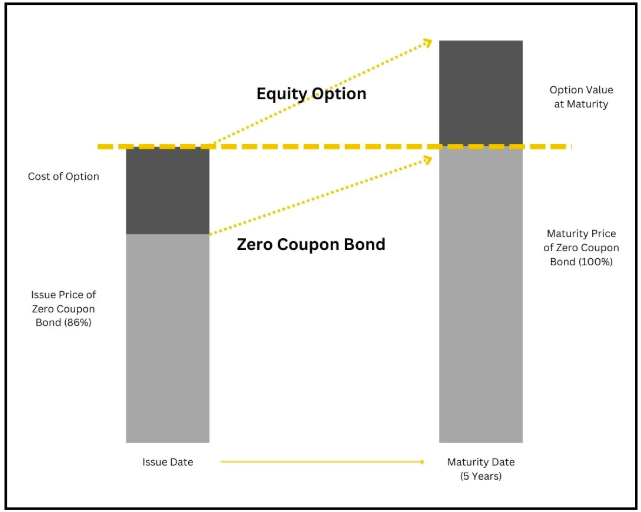Decoding Structured Products: A Beginner’s Guide to a New Asset Class
.png)
Decoding Structured Products: A Beginner’s Guide to a New Asset Class
Introduction
The term “structured product” can seem intimidating and overly complex, but it is not as complicated as it may initially appear.
Consider a scenario where a novice investor is given two options:
- Buy shares of Apple.
- Buy a structured product linked to the same Apple shares.

Most investors would likely choose the first option because of its familiarity, viewing the structured product as a “black box”. However, if the choice was re-phrased as, “Would you like to buy shares of Apple directly, or would you prefer an investment option that customizes your risk and return in a way that better matches your needs?” the perception changes. This highlights that a structured product is essentially a customized investment. Using the term “customized investment” is more approachable and accurately describes the product.
Origins and Structure
A structured product is an investment tailored to an investor’s specific needs, including the choice of the underlying asset, maximum acceptable loss, and investment duration.
Originally Issued as a Cheaper Source of Funding
Banks initially created structured products to lower their funding costs. Instead of issuing standard coupon-paying bonds, they issued notes with an embedded option linked to an underlying asset’s performance. The bank would use the proceeds like a regular bond but would invest a portion in an option for the investors instead of paying a conventional coupon.
A Mutually Beneficial Arrangement
This was advantageous for both parties:
- For the Bank: The cost of the embedded option was typically lower than the interest on a standard bond, making it a cheaper funding method.
- For the Investor: It allowed for more interesting payoff profiles and gave investors restricted to bonds access to returns linked to equities, commodities, and other asset classes within a bond-like structure.
The “Zero Plus Call”
Early structured products were often simple “zero plus call” structures, which included:
- Zero-Coupon Bond: This secures the principal and ensures capital protection at maturity.
- Call Option: This provides exposure to the potential upside of an underlying asset.
These components create a note that protects the principal while offering upside participation if the asset appreciates.
Illustrative Example and Core Components
Bank Funding Costs
If a bank can raise five-year funds at about 3 % per annum, its total interest cost over that period would be around 15 %. This means the present value of the bank’s five-year zero-coupon bond is about 85 % of its face value. A five-year call option on an equity index might cost around 14 % of the notional value.
Putting It All Together
The bank can bundle the zero-coupon bond (~85 %) with the 14 % call option. Instead of a 3 % annual coupon, it offers investors participation in the index’s upside over five years with principal protection. This was appealing to many investors as they got the full upside if the index rose and capital protection if it performed poorly.

Zero Coupon + Call: The Core Components
This structure, also known as a capital-protected note, has two main parts:
- Zero-Coupon Bond: Priced at a discount initially (e.g., 86 % of face value) and redeems at 100 % at maturity, protecting the principal.
- Call Option: Provides upside potential if the underlying asset rises. If the asset falls, the option expires worthless, but the zero-coupon bond still returns the principal in full.
Evolution and Popular Products
From Cheaper Funding to a Stand-Alone Business
Structured notes evolved from a cost-reduction tool for banks into a new profit center. Today, nearly every major global bank has a structured products desk as a key part of its derivatives operations. While some funding benefits remain, revenue is now mainly generated by marking up the value of the packaged investment. Investors gain capital protection and the potential for market-linked returns.
The Most Popular Structured Products
The world of structured products is vast and highly customizable. It is more important to understand the payoff structure and risk profile than the marketing name. Before investing, one should ask:
- In which scenarios will I make money?
- What are my risks?
- Does this product fit my investment objective?
Reverse Convertible
A Reverse Convertible pays a guaranteed coupon and returns 100 % of the principal at maturity, provided the underlying asset does not fall below a specified barrier.
Example Setup
- Underlying: Apple
- Term: 6 months
- Barrier Level: 70 %
- Coupon: 10 % p.a.
Reverse Convertible Scenarios and Profile
Return Scenarios at Maturity
- If the underlying finishes above the protection barrier: The investor receives 100 % of the principal plus the coupon.
- If the underlying finishes below the barrier: The investor typically receives physical delivery of the shares at the strike price, which may be worth less than the initial investment.
The coupon is guaranteed regardless of the underlying’s performance. Profitability depends on the underlying’s price at maturity. The full principal is returned as long as the underlying has not declined by more than 30 %.
Potential Risks
If the underlying asset drops significantly (more than 30 %), the principal is at risk. For example, if Apple finishes at 60 % of its initial price, the investor would only recover 60 % of their capital.
Investor Profile Checklist
- Is primarily seeking income.
- Wants protection against a limited downside.
- Expects the underlying’s performance to be mildly positive or slightly negative.
This product exchanges some potential upside for a fixed coupon and partial protection.
Autocallable
An Autocallable product is similar to a reverse convertible but includes a feature for early termination if certain conditions are met on observation dates. It pays a coupon and provides principal protection as long as the underlying does not breach a barrier. If the underlying is trading above its initial level on a specified date, the product redeems early. Otherwise, it continues to the next observation date.
Autocallable Scenarios and Profile
Example Setup
- Underlying: Apple
- Term: 12 months
- Barrier: 70 %
- Coupon: 12 % p.a. (observed quarterly)
Return Scenarios
- At Each Quarterly Observation
- If the underlying is above the autocall trigger, early redemption occurs, and the investor gets 100 % of the principal plus any accrued coupon.
- If it is below the trigger, the product continues, and the coupon is paid.
- At Maturity
- If the underlying is above the protection barrier, the investor receives 100 % of the principal plus the final coupon.
- If it finishes below the barrier, the investor receives shares or a cash equivalent, which may be worth less than the initial investment.
The coupon is guaranteed. Profitability depends on the underlying’s price, and the principal is recovered if the price has not declined by more than 30 %.
Potential Risks
If the underlying declines by more than 30 %, the investment is at risk. For example, if it ends at 60 % of its initial value, the investor recoups only 60 % of the invested capital.
Checklist for Investor Profile
- Is income-focused.
- Wants to shield against some downside risk.
- Is comfortable with the possibility of early redemption.
Participation Notes
This product is suitable for those prepared to exchange uncertain stock upside for a steadier income stream and partial downside protection.
Participation notes are growth-oriented products that allow investors to share in the underlying asset’s performance, unlike income-focused structures. Instead of coupons, the investor gains from the asset’s upside.
Return Scenarios at Maturity
- If the underlying finishes above the protection barrier: The investor receives 100 % of the principal plus 100 % of the upside in the asset’s price.
- If the underlying finishes below the barrier: The investor receives shares or a cash equivalent, which could be worth less than the initial investment.
A gain is realized if the underlying’s share price is higher at maturity, with the amount depending on the level of appreciation.
Potential Risks
The main risk is a significant drop in the underlying’s price (e.g., more than 20 %). For instance, if the asset ends at 70 % of its starting value, the investor would recover only 70 % of their investment.
Participation Note Profile
Checklist for Investor Profile
- Is looking for capital appreciation.
- Wants to mitigate the risk of a falling share price to some extent.
- Believes the underlying’s share price is likely to perform positively.
This structure allows for keeping upside potential while enjoying some protection against moderate declines.
Why Have Structured Products Become So Popular?
- Income Generation: Many notes like reverse convertibles and autocallables are designed to generate income, offering attractive coupon rates (5 % to 50 % annually) while mitigating downside risk. They are appealing in low-interest-rate environments.
- Democratization: Once limited to wealthy investors with high minimums (e.g., USD 5 million), innovations now allow customization for as little as USD 50,000. This is due to automation and more efficient industry processes.
- Competition: Increased competition among banks and issuers has led to greater price transparency and more favorable terms for investors. Constructing a note can be more cost-effective than replicating the strategy with listed options.
- Emergence of Independent Platforms: These platforms allow investors to compare offerings from multiple issuers to secure the best terms and pricing.
- Liquidity: While previously difficult to sell before maturity, most modern structured notes can now be unwound in a relatively liquid market, allowing investors to exit at a fair price before maturity.
Join Our Team
Explore More Blogs
Yes, You Are on the
Fintech banking advanced technology to offer agile, user friendly & services to traditional banking.




.png)
.png)

.png)
.png)




